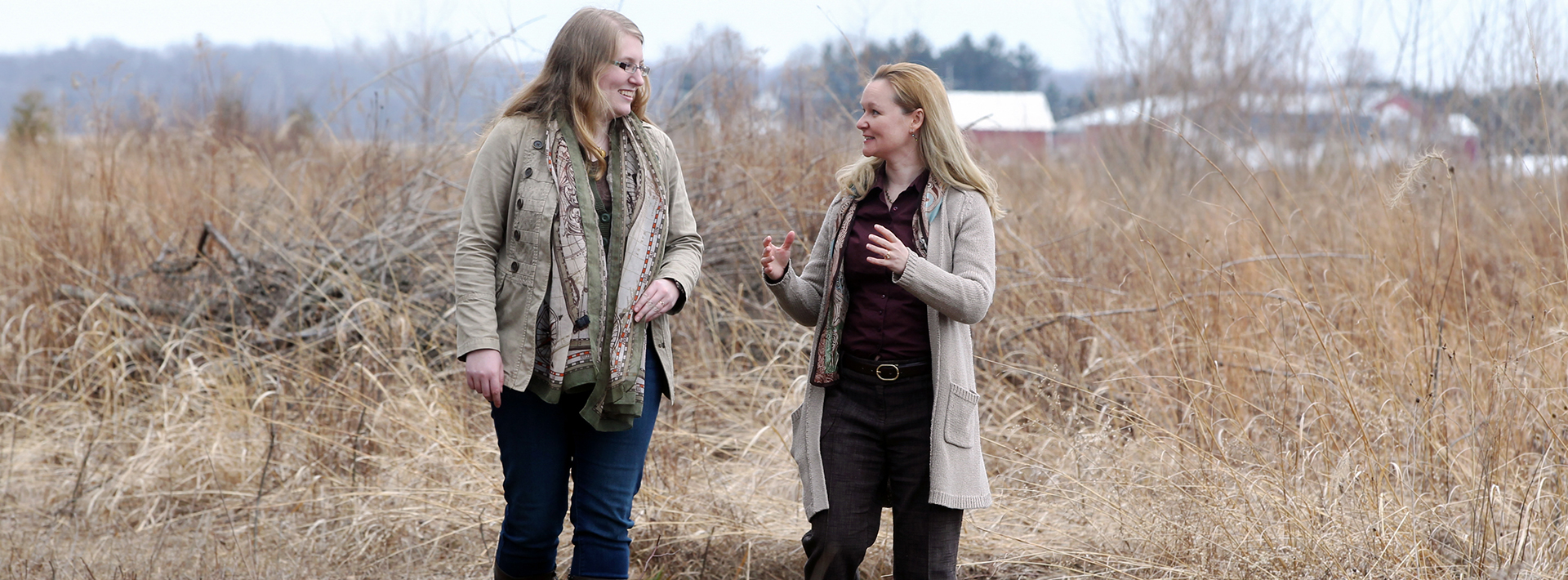For love and money
Class publishes fundraising guide for land trusts
 Graduate student Meredith Barnes (left) and Dr. Shannon Orr walk over land protected by the Black Swamp Conservancy. The property is owned by BGSU biology faculty Drs. Moira Van Staaden and Robert Huber, who signed a conservation easement with the conservancy.
Graduate student Meredith Barnes (left) and Dr. Shannon Orr walk over land protected by the Black Swamp Conservancy. The property is owned by BGSU biology faculty Drs. Moira Van Staaden and Robert Huber, who signed a conservation easement with the conservancy.
Moving people from wanting to see land spared from development to actually donating money to help conserve it requires a skill set that many grassroots land trust groups do not possess.
But there are tangible steps that are effective in creating support, and Dr. Shannon Orr’s fall 2014 Environmental Management class is sharing that information through an academic paper in New Visions for Public Affairs, a student-run, peer-reviewed journal. “Fundraising during an Economic Downturn: Best Practices for Nonprofit Organizations” will be published in the May edition of the journal, just after the students graduate.
“Having a published article on our resumes will be really great when we’re looking for jobs,” said class member Meredith Barnes, a Master of Public Administration Program student from the Akron area. “We were ecstatic when we learned it had been accepted.”
Publishing was not the original intent when the class took on as a client the local Black Swamp Conservancy, which had asked for help in identifying fundraising practices. Like most regional conservancy groups, its membership is made up of volunteers, who typically do not have fund-raising expertise.
The class did such a good job and the results were so impressive that Orr felt they should be shared more widely than only with the survey respondents. The article fills a knowledge gap. “This is a high-priority need, but there’s been almost nothing about best practices in fundraising for land trusts published in academic journals,” said Orr, director of the MPA program in the political science department. “I think it will be well cited. We’ll see over the next five years. This was such a good project.”
Being published was also gratifying for the five class members, given the amount of work required to plan, write, implement and compile the results of the survey, and then, unexpectedly, to take it one step further and turn the original report they wrote into a more analytical academic paper.
“Environmental causes receive only 3 percent of the giving pie, and sometimes it’s down to 2 percent,” said Sarah Brokamp, Black Swamp Conservancy advancement coordinator. “We were interested to know how other land trusts overcome this big hurdle and make themselves stand out among all the other worthy causes.”
Barnes and classmates Tara Schuler, Tao Tang, Sarah Tekle and Christopher Van Newhouse conducted a Web-based national survey of all other U.S. land trusts to see what works, how much time it takes, what the challenges are and what advice they had to offer. Many of the 132 respondents admitted to being equally in the dark, Orr said, but others shared successful strategies.
“Their guidance was very consistent,” Barnes said.
“We were very interested to read the report, and I thought, ‘There are some gems in here we hadn’t thought of,’” Brokamp said. “We’re a very small nonprofit, with only three full-time and two part-time employees, and it’s hard to know where your time and budget are best spent. We need to reach out to the different generations in different ways.”
Land trusts need to nurture relationships with their supporters, moving from simply holding a 5K race, for example, to extending their connection with attendees after the event and making them feel invested in the organization. They need to communicate clearly what they do and build understanding of why the work is important.
“You need to communicate in a confident, open manner and be proud of what you’re doing,” Barnes said. “You need to educate so that people come to understand the benefit of preserving this stream or wetland.
“To reach young people, you need to do something that takes them away from reality, and make it a fun event. Contests are very good. You can hold a river cleanup challenge — and always provide food,” she added humorously.
“And you need to actually ask for donations, but ask nicely. Our respondents reported that the small donations really add up.”
Also important is having a strong board of directors who understand the mission of the land trust and are willing to give their financial support, Orr said.
Most land trust organizations put all money raised directly into their acreage’s restoration and conservation, the class found.
“What impressed me most about these organizations was just how passionate they are about their cause,” Barnes said. “And they were so enthusiastic about our research. It made all the work worthwhile to see an abstract idea coming into something they can really use.”
Through the project and the writing of the paper, the class gained “foundational skills,” Orr said, including how to compose effective survey questions, research methods, presentation skills and academic reporting, along with something about nonprofit management, fundraising and the history of land trusts.
Having received her undergraduate degree from BGSU in environmental science, Barnes was especially enthusiastic about the project and pleased to be able to assist in land conservation.
After graduation, she aspires to work in the policy arena, where she feels she can have a much bigger impact. “I enjoy the hands-on work and will always volunteer but I feel the best way to save the environment is on the policy side.”
Updated: 12/02/2017 12:42AM
